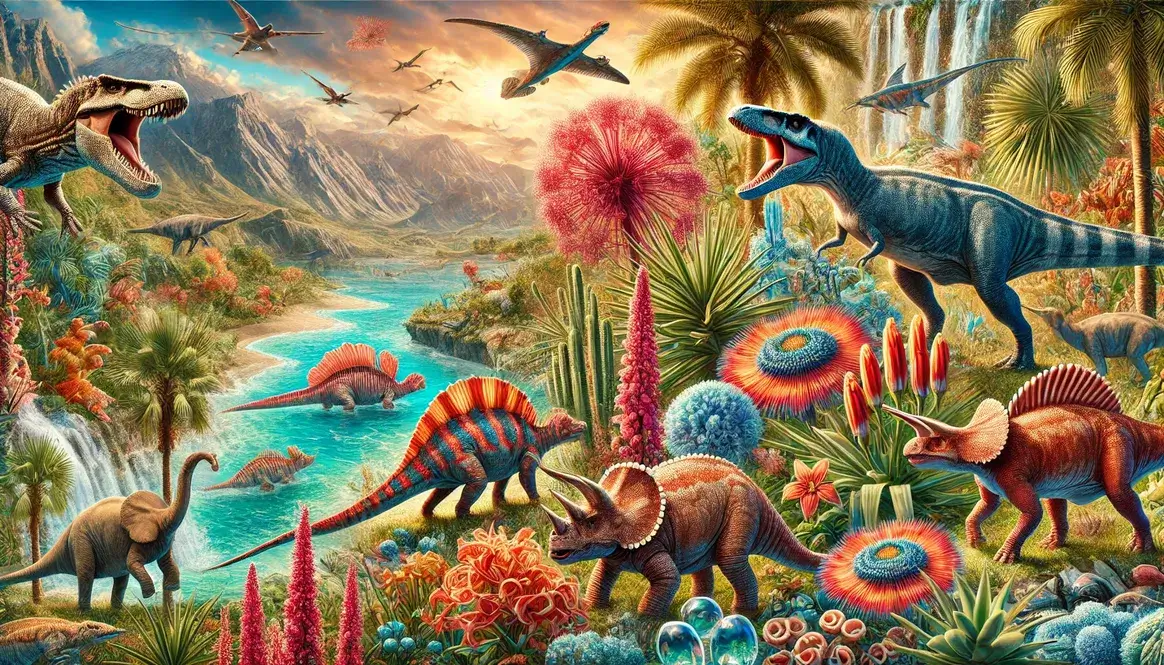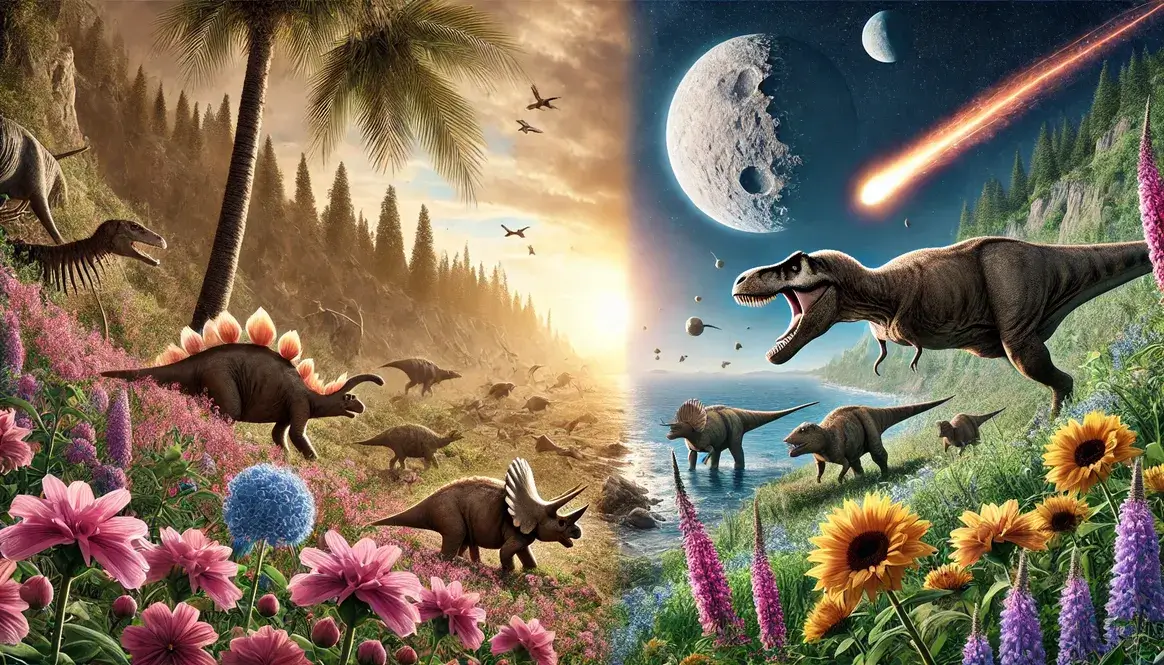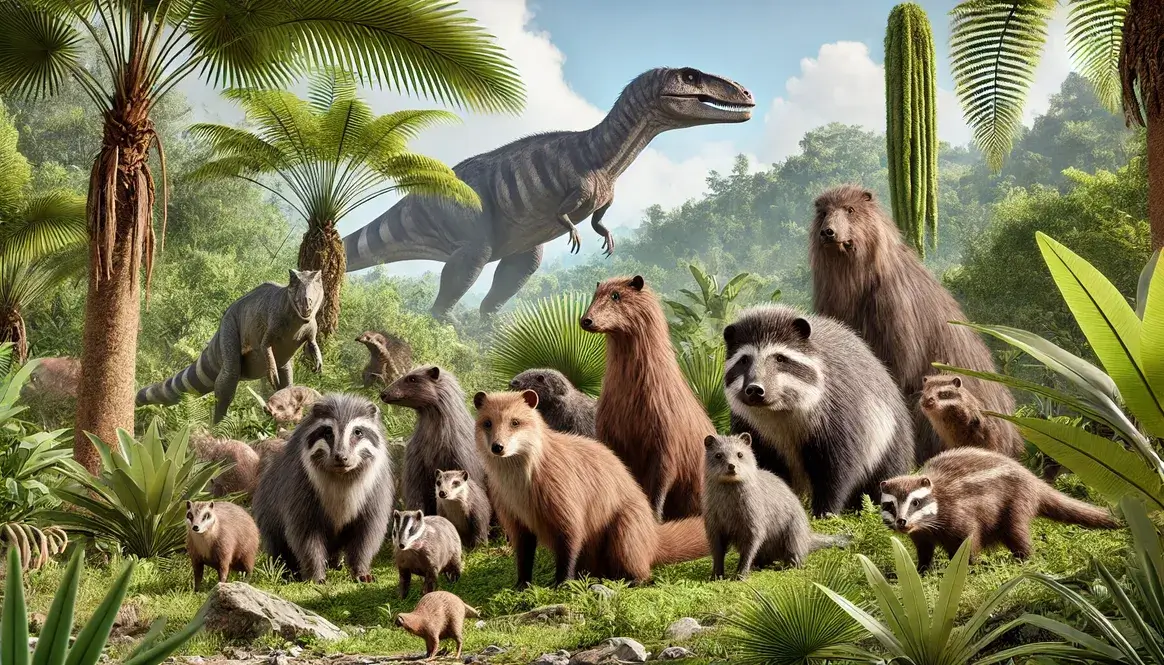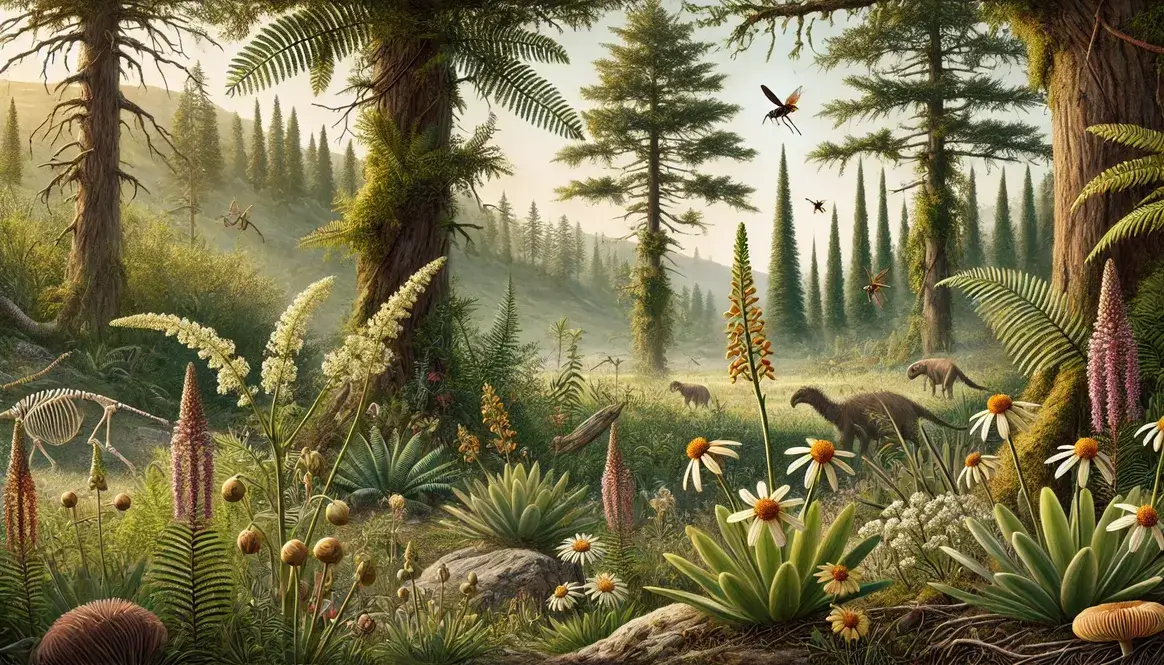The Cretaceous period, spanning from 145 to 66 million years ago, was a time of extreme warmth and dramatic climate shifts. During this era, dinosaurs roamed the Earth, and the world looked very different from what we know today. Let’s explore the fascinating Cretaceous climate and how it shaped life on our planet.
Early Cretaceous Climate (145-100 million years ago)
As the Cretaceous period began, Earth was already experiencing a warm climate. But things were about to heat up even more! The early Cretaceous saw a continuation of the greenhouse conditions that had started in the late Jurassic, but with some key differences.
Several factors influenced the Cretaceous climate:
- Continental positions: The continents were still clustered together, forming the supercontinent Pangaea.
- High levels of carbon dioxide (CO2) in the atmosphere
- Intense volcanic activity
- Absence of polar ice caps
Compared to the late Jurassic, the early Cretaceous was even warmer and more humid. This shift set the stage for significant changes in Earth’s ecosystems and the creatures that inhabited them.
Warm Temperatures and High Sea Levels
During the early Cretaceous, Earth was much warmer than it is today. Average global temperatures were about 4°C (7°F) higher than our current climate. That might not sound like much, but it made a big difference!
These warm temperatures led to some interesting effects:
- No polar ice caps: The poles were ice-free, with temperatures warm enough to support forests.
- Higher sea levels: With no ice locked up at the poles, sea levels were much higher than they are today.
- Expanded shallow seas: Many coastal areas were underwater, creating vast shallow seas.
Let’s look at how high the sea levels were compared to today:
| Time Period | Sea Level (compared to present) |
|---|---|
| Early Cretaceous | 100-200 meters higher |
| Present Day | 0 meters (baseline) |
These high sea levels had a big impact on coastal regions and marine life. Many areas that are dry land today were underwater during the Cretaceous. This created new habitats for marine creatures and changed the way animals and plants were distributed across the globe.
Climate Zones in the Early Cretaceous
Even though the Earth was warmer overall, there were still different climate zones. Let’s explore what these zones were like:
- Equatorial Zone:
- Very hot and humid
- Heavy rainfall year-round
- Lush tropical forests
- Temperate Zones:
- Warm and mild
- Seasonal changes, but no extreme cold
- Mixed forests and open woodlands
- Polar Zones:
- Much warmer than today’s poles
- No permanent ice
- Forests instead of tundra
Each of these zones had its own unique plants and animals. For example, the equatorial zones were home to many types of plant-eating dinosaurs, while the temperate zones saw a mix of different dinosaur species.
The warm polar regions were particularly interesting. Instead of the icy landscapes we see today, the Cretaceous poles had forests! These forests were home to dinosaurs that had adapted to live in a world with long summer days and long winter nights.
Mid-Cretaceous Climate (100-80 million years ago)
As we move from the early to the mid-Cretaceous, Earth’s climate continued to evolve. This period saw some of the most extreme warming in our planet’s history, reshaping landscapes and ecosystems worldwide.
The mid-Cretaceous was marked by:
- Even higher global temperatures
- Rising sea levels
- Increased CO2 levels in the atmosphere
- Major changes in ocean circulation
These changes didn’t happen overnight. They were part of a gradual warming trend that reached its peak during this time.
Peak Warmth: The Cretaceous Thermal Maximum
Around 93-90 million years ago, Earth experienced a super-hot spell known as the Cretaceous Thermal Maximum. This was the warmest period of the last 144 million years!
During this time:
- Global temperatures were 5-8°C warmer than today
- CO2 levels were 1000 parts per million (ppm) or higher
- Sea levels reached up to 250 meters above current levels
But what caused this extreme heat? Scientists believe several factors contributed:
- Increased volcanic activity
- Release of methane from ocean sediments
- Changes in ocean circulation patterns
The effects of this warming were dramatic. Imagine a world where palm trees grew in Antarctica and crocodiles swam in the Arctic! This wasn’t science fiction – it was the reality of the Cretaceous Thermal Maximum.
| Region | Modern Climate | Cretaceous Thermal Maximum Climate |
|---|---|---|
| Arctic | Ice and tundra | Temperate forests, no ice |
| Equator | Tropical | Super-tropical, extreme heat |
| Antarctica | Ice sheet | Temperate forests, no ice |
This extreme warmth had a profound impact on life. Many species thrived in the hot, humid conditions. Dinosaurs reached their peak diversity during this time. In the oceans, new groups of marine reptiles evolved to take advantage of the expanded shallow seas.
Shifting Climate Zones
As the Earth heated up, climate zones shifted dramatically. The mid-Cretaceous saw:
- Expansion of tropical and subtropical zones towards the poles
- Shrinking of temperate zones
- Disappearance of cold climates
This reshuffling of climate zones had big implications for plants and animals. Species that were adapted to cooler climates had to move towards the poles or face extinction. Meanwhile, heat-loving species expanded their ranges.
The expansion of tropical and subtropical regions led to:
- Spread of tropical rainforests
- Increase in diversity of flowering plants
- New opportunities for heat-adapted animals
For example, the ancestors of modern crocodiles, which prefer warm climates, were found much farther north and south than they are today. Even the poles weren’t safe from this tropical invasion – fossil evidence shows that dinosaurs lived in polar regions, which were warm enough to support forests.
These shifts didn’t just affect land animals. Marine life also had to adapt to changing conditions. Warmer oceans meant that some species had to migrate to cooler waters, while others thrived in the heat.
Late Cretaceous Climate (80-66 million years ago)
As the Cretaceous period entered its final act, the climate began to shift once again. The extreme warmth of the mid-Cretaceous gave way to a more varied and dynamic climate system. This period set the stage for the dramatic events that would eventually end the reign of the dinosaurs.
Several factors influenced the late Cretaceous climate:
- Continuing continental drift
- Changes in ocean circulation
- Variations in greenhouse gas levels
- Potential asteroid impacts
These factors combined to create a climate that was cooler than the mid-Cretaceous but still much warmer than today’s world.
Cooling Trends and Fluctuations
The late Cretaceous saw a gradual cooling trend, though temperatures remained higher than in our current era. Evidence for this cooling comes from several sources:
- Oxygen isotope ratios in fossil shells
- Plant fossil records showing changes in vegetation
- Sediment analysis indicating shifts in weathering patterns
However, this cooling wasn’t a smooth, consistent process. The climate experienced significant fluctuations, with periods of warming interspersed with cooler spells. These temperature swings could happen over thousands or even millions of years.
What caused these fluctuations? Scientists point to several possible factors:
- Changes in volcanic activity
- Shifts in ocean currents
- Variations in Earth’s orbit (Milankovitch cycles)
These climate changes had a significant impact on dinosaurs and other animals. As temperatures fluctuated, so did the availability of food and suitable habitats. Some species thrived, while others struggled to adapt.
For example, during cooler periods:
- Some large herbivorous dinosaurs may have migrated to warmer areas
- Certain plant species became less abundant, affecting the food chain
- Cold-adapted species might have expanded their ranges
Meanwhile, during warmer spells:
- Tropical species could expand their territories
- Some marine reptiles might have flourished in warmer seas
- Certain plant species could have experienced growth spurts
Regional Climate Variations
While global climate trends are important, the late Cretaceous also saw significant regional variations in climate. Different parts of the world experienced unique conditions, influenced by factors like latitude, ocean currents, and local geography.
Let’s look at some examples:
North America: The Western Interior Seaway, a vast inland sea, created a unique climate in the heart of the continent. This warm, shallow sea influenced local weather patterns and supported a diverse ecosystem. Along its shores, Tyrannosaurus rex and other predators hunted their prey.
Europe: Much of Europe was an archipelago of islands. This created a warm, humid climate with abundant rainfall, perfect for lush vegetation and diverse dinosaur life.
Antarctica: Despite being located at the South Pole, Antarctica was ice-free and covered in forests. However, it experienced long periods of darkness during winter months, creating unique challenges for plant and animal life.
These regional variations had a profound influence on local ecosystems and biodiversity. Different areas supported different types of plants and animals, leading to a wide variety of dinosaur species adapted to specific local conditions.
| Region | Climate Characteristics | Notable Fauna |
|---|---|---|
| North America (Western Interior) | Warm, humid, influenced by inland sea | T. rex, Triceratops |
| Europe | Warm, humid archipelago | Iguanodon, Megalosaurus |
| Antarctica | Cool temperate, extreme seasonal light changes | Early marsupials, small dinosaurs |
As the Cretaceous period neared its end, these regional climates would play a crucial role in determining which species survived and which perished in the coming extinction event. The adaptations that helped species thrive in their local environments would be put to the ultimate test.
Cretaceous Climate Drivers
The Cretaceous climate was shaped by a complex interplay of various factors. These drivers worked together to create the unique conditions that characterized this fascinating period of Earth’s history. Let’s explore the major players that influenced the Cretaceous climate.
Volcanic Activity and CO2 Levels
Volcanic activity played a crucial role in shaping the Cretaceous climate. Large-scale eruptions were common during this period, particularly from massive volcanic provinces known as Large Igneous Provinces (LIPs).
Key volcanic events included:
- The formation of the Ontong Java Plateau (around 120 million years ago)
- The eruption of the Deccan Traps (towards the end of the Cretaceous)
These volcanic eruptions had a significant impact on the climate:
- CO2 Release: Volcanoes pumped enormous amounts of CO2 into the atmosphere. This led to increased greenhouse warming.
- Ash and Aerosols: Volcanic eruptions also released ash and aerosols, which could temporarily cool the planet by blocking sunlight.
- Long-term Effects: The weathering of volcanic rocks over time actually helped to remove CO2 from the atmosphere, potentially leading to cooling.
The relationship between volcanism, CO2, and global temperatures was complex. While volcanic activity generally increased CO2 levels and temperatures, the effects could vary depending on the scale and duration of eruptions.
| Time | CO2 Levels (ppm) | Average Global Temperature |
|---|---|---|
| Early Cretaceous | 1000-1500 | 4°C warmer than today |
| Mid-Cretaceous | 1500-2000 | 5-8°C warmer than today |
| Late Cretaceous | 1000-1500 | 2-3°C warmer than today |
These high CO2 levels created a powerful greenhouse effect, trapping heat and contributing to the warm Cretaceous climate.
Ocean Circulation Patterns
Ocean currents played a vital role in distributing heat around the globe during the Cretaceous. The arrangement of continents and sea levels significantly influenced these circulation patterns.
In the early Cretaceous, ocean circulation was characterized by:
- Sluggish deep water formation
- Limited mixing between surface and deep waters
- Warm water spreading from the equator to the poles
As the period progressed, several changes occurred:
- The opening of the South Atlantic Ocean created new pathways for ocean currents.
- The deepening of ocean basins allowed for more vigorous circulation.
- Cooler temperatures towards the end of the period may have led to increased deep water formation.
These changes in ocean circulation had far-reaching effects. They influenced not only global climate but also marine ecosystems. For example, changes in upwelling patterns could affect nutrient distribution, impacting marine food chains from plankton all the way up to large marine reptiles.
The warm, shallow seas that covered much of the continents during the Cretaceous also played a role in climate regulation. These seas could store large amounts of heat, helping to maintain warm temperatures even at high latitudes.
Orbital Variations and Climate Cycles
Even in the midst of the Cretaceous greenhouse, Earth’s climate wasn’t static. It oscillated due to regular changes in Earth’s orbit, known as Milankovitch cycles.
These cycles include:
- Eccentricity: Changes in the shape of Earth’s orbit (every 100,000 and 400,000 years)
- Obliquity: Changes in the tilt of Earth’s axis (every 41,000 years)
- Precession: Wobble in Earth’s axis (every 19,000 to 23,000 years)
These orbital variations affected the amount and distribution of solar energy reaching Earth, causing cyclical climate changes.
Evidence for these cycles can be found in the geological record. For example, scientists have identified regular patterns in sedimentary rocks that correspond to Milankovitch cycle frequencies.
Understanding these cycles has important implications:
- It helps explain short-term climate fluctuations within the overall warm Cretaceous period.
- It provides insights into the sensitivity of Earth’s climate to small changes in solar input.
- It allows scientists to better interpret past climate changes and predict future ones.
These natural climate cycles operated alongside the other climate drivers, creating a dynamic and ever-changing Cretaceous climate. This interplay of factors created the conditions that allowed dinosaurs and other Cretaceous life forms to thrive, shaping the course of evolution on our planet.
Life in the Cretaceous Greenhouse
The Cretaceous climate was a powerful force that shaped the evolution and distribution of life on Earth. From the smallest microorganisms to the largest dinosaurs, every living thing had to adapt to the warm, often humid conditions of this greenhouse world.
Adaptations to Warm Climates
Plants and animals developed various strategies to thrive in the Cretaceous climate. Let’s explore some of these fascinating adaptations:
Plant Adaptations:
- Efficient water use in hot conditions
- Rapid growth to take advantage of high CO2 levels
- Development of new leaf structures for better cooling
One of the most significant plant developments during this time was the rise of flowering plants. These angiosperms evolved characteristics that made them well-suited to the Cretaceous climate, such as:
- Diverse pollination strategies
- Efficient water transport systems
- Rapid life cycles
Animal Adaptations: Cretaceous animals also evolved unique features to cope with the warm climate:
- Dinosaurs: Many species developed elaborate cooling systems, such as:
- Large sail-like structures (e.g., Spinosaurus)
- Complex nasal passages for heat exchange
- Possible behavioral adaptations like mud-bathing
- Marine Reptiles: Adapted to the warm, shallow seas with:
- Streamlined bodies for efficient swimming
- Ability to regulate body temperature in water
- Early Mammals: Developed strategies to survive alongside dinosaurs:
- Nocturnal habits to avoid daytime heat
- Burrowing behavior for temperature regulation
The Cretaceous climate created unique ecosystems unlike anything we see today. For example, the polar forests of Antarctica supported a diverse array of life, including dinosaurs adapted to months of darkness during winter.
Climate-Driven Evolution
The Cretaceous climate was a powerful evolutionary force, driving the development of new species and the extinction of others. This period saw an explosion of biodiversity, particularly among flowering plants and insects.
Climate-driven evolutionary changes included:
- Development of drought-resistant plants in seasonally dry areas
- Evolution of large body sizes in some dinosaur lineages, possibly aided by abundant plant growth
- Adaptation of marine reptiles to life in warm, shallow seas
Let’s look at a specific example: the evolution of duck-billed dinosaurs (hadrosaurs). These herbivores developed complex dental batteries – rows of teeth that were constantly replaced – allowing them to efficiently process the tough vegetation that thrived in the Cretaceous climate.
| Dinosaur Group | Climate-Driven Adaptation |
|---|---|
| Hadrosaurs | Complex dental batteries for processing tough plants |
| Sauropods | Long necks to reach high vegetation in forests |
| Theropods | Diverse sizes to fill various niches in productive ecosystems |
The long-term impacts of these climate-driven changes were profound. Many of the plant and animal groups that evolved during the Cretaceous continue to play important roles in modern ecosystems. The diversity of flowering plants, for instance, laid the foundation for the complex terrestrial ecosystems we see today.
End-Cretaceous Climate: Prelude to Extinction
As the Cretaceous period drew to a close, the climate was already changing. The last few million years of the Cretaceous saw cooling trends and sea level fluctuations. These changes set the stage for the dramatic events that would end the age of dinosaurs.
Climate conditions in the late Cretaceous included:
- Gradual global cooling
- Falling sea levels
- Increased seasonality in many regions
However, it’s important to note that the climate was still much warmer than today, with no polar ice caps and tropical conditions extending to high latitudes.
The role of climate in the extinction of the dinosaurs is a subject of ongoing debate among scientists. While the asteroid impact at the end of the Cretaceous is widely accepted as the primary cause of the mass extinction, some researchers argue that climate change may have played a contributing role.
Possible climate-related factors in the extinction include:
- Gradual cooling making some species more vulnerable
- Changes in plant communities affecting herbivorous dinosaurs
- Sea level changes altering coastal habitats
The transition to the post-Cretaceous climate was dramatic. The asteroid impact caused severe short-term cooling, followed by a period of global warming due to the release of greenhouse gases. This climate instability likely contributed to the severity of the mass extinction.









